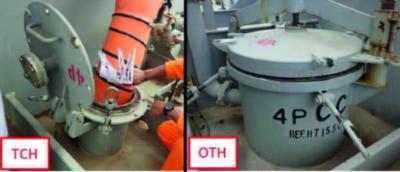202427: Dangerous gas-freeing practice claims one victim
As edited from official TSIB (Singapore) report TIB/MAI/CAS.126
An oil/chemical tanker was underway. The cargo tanks had been cleaned in preparation for a docking survey and the Chief Officer (CO) had lined up the clean tanks for gas-freeing.
Three tanks were connected to a common pipeline. Fresh air from the fixed gas-freeing air fan inside the ballast pump room was directed through the pipeline to a portable air chute directing the air into the tanks. Once the line-up was completed gas-freeing commenced. The CO gave verbal instructions for completing the gas-freeing operations before retiring to his cabin for rest.
At about 23:50, a relieving bridge crew member (lookout) met up with the out-going lookout. They both went on deck to change the portable air chute from one tank to another. After completing the task, the off-watch crew member stood down and the on-duty crew member returned to the bridge to join the Officer of the Watch (OOW) as lookout.
About two hours later, the lookout left the bridge to change the portable air chute to the third tank, according to the instructions given by the CO. As the lookout left the accommodation block and went on deck he performed a VHF radio check with the OOW on the bridge, which was acknowledged.
About 20 minutes after the lookout’s last VHF report, the OOW called back to check the status of the task but did not receive a response. The OOW tried a few more calls, without success. The OOW then called other common spaces inside the accommodation using the ship’s internal telephone but could not locate the lookout. He then called the duty engineer and requested assistance to locate the lookout.
Soon after the victim was found lying unconscious on the starboard side main deck. The Master was informed and the alarm was raised. There were no signs of injury on the victim’s body but there were no signs of breathing either and no pulse was detected. CPR was commenced and continued for many hours but the efforts were fruitless. The victim was declared deceased and the vessel proceeded to a nearby port to disembark the body.
Some of the official report findings, among others, were:
- After tank cleaning, the tank cleaning hatch (TCH) had been kept open and the oil tight hatch (OTH) was cracked open for the gasfreeing operation. This allowed gas vapours to accumulate on deck (open loop). This practice deviated from the company’s Safety Management System (SMS) requirement that flammable and/or toxic gases from tanks could be vented only through the approved tank venting system (closed loop).
- The gas-freeing operation was conducted by directly connecting the portable air chutes to the tank cleaning hatches. The atmosphere of the tanks was not checked to verify gas concentration was within safe limits before connecting the chutes.
- The fixed gas-freeing fan was not stopped before the portable chute was changed from one tank to another.
- The victim had likely inhaled remnants of nitrogen gas and/or toxic vapours while changing the portable chute from one tank to another.
- The victim was not carrying a portable gas detector which could have alerted him of the low oxygen level or presence of toxic gases on deck. But neither had he been instructed to do so.

- When a lookout performs deck work the duties of lookout are not being accomplished.
Lessons learned
- Nitrogen in concentration is lethal and one breath is enough to cause unconsciousness.
- A person need not be in a confined space to inhale a deadly concentration of noxious gas.
- Safety ‘slippage’ happens when procedures are not followed and work practices begin tipping into the danger zone. In this case, deck crew and officers did not appear to be aware of the SMS procedure.
- It is not enough to establish procedures without also ensuring the necessary training in their application and actual implementation in practice.
Editor’s note: Twenty years after the Bow Mariner explosion claimed 21 lives, it is hard to understand why the practice of open tank hatches during tank cleaning continues (as on the Bow Mariner) or that it is used as a means to gas-free cargo tanks on chemical tankers.
